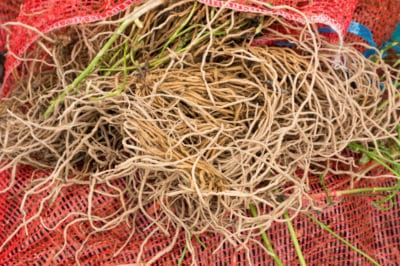Growing and Transplanting Asparagus Seedlings
Start asparagus seeds 12 to 14 weeks before transplanting seedlings into the garden. Start the seeds in trays in the greenhouse or under a grow lamp indoors. Plant seeds ½ inch (1.3cm) deep in soil mix in cells as small as 1.5 by 1.5 inches (3.8 by 3.8cm) by 2 inches (5cm) deep, planting one seed per cell.
Keep the seeds damp and within a temperature range of 75ºF to 85ºF (23.8ºC to 29.4ºC) for up to three weeks until seeds germinate. Once the seedlings are growing, reduce the temperature to 70ºF-75ºF (21.1ºC to 23.8ºC) during the day and 60ºF to 65ºF (15.5ºC to 18.3ºC) at night.
When seedlings are between 12 to 14 weeks old after germinating, they are ready for transplanting into the garden, as long as outdoor temperatures are above 50ºF (10ºC).
In the asparagus bed, dig trenches approximately 16 inches (40.6cm) wide and 6 to 8 inches (15 to 20cm) deep and long enough to space the transplants approximately 10 to 18 inches (25.4 to 45.7cm) apart. At the bottom of the trench, form a mound of soil running the length of the trench to keep seedlings slightly elevated above the bottom.
Gently place the seedling on top of the mound, and fill in soil around them until it is slightly higher than the depth to which the seedling was previously planted. Water thoroughly and tend the growing plants as needed.
Transplanting Asparagus Crowns from Mature Plants
Asparagus is a slow growing plant which takes four years to produce harvestable shoots when grown from seed. However, you can also start asparagus from one year old crowns or transplant mature roots from one garden to another or from a wild asparagus source.
To transplant mature asparagus crowns:
- Dig up the roots in early spring when the plants are still dormant and the soil is moist.
- Use a garden fork for loosening the root mass, and carefully separate and trim individual crowns.
- Prepare the new asparagus bed in advance, then place the crowns on a mound of compost at the bottom of the trench, taking care to spread the roots out in all directions and cover with soil.
- Be sure the pointed bud end of the crown is facing upward when planting.
Let most of the shoots grow into ferns the first year, lightly harvesting spears for eating until the plants are established in their new home.
